ASRock X79 Extreme4-M and X79 Extreme4 Review – Sandy Bridge-E meets mATX
by Ian Cutress on December 9, 2011 12:00 PM EST- Posted in
- Motherboards
- ASRock
- X79
USB Speed
For this benchmark, we run CrystalDiskMark to determine the ideal sequential read and write speeds for the USB port using our 64GB Patriot SuperSpeed USB 3.0 drive. Then we transfer a set size of files from the SSD to the USB drive, and monitor the time taken to transfer. The files transferred are a 1.52 GB set of 2867 files across 320 folders – 95% of these files are small typical website files, and the rest (90% of the size) are the videos used in the Sorenson Squeeze test.
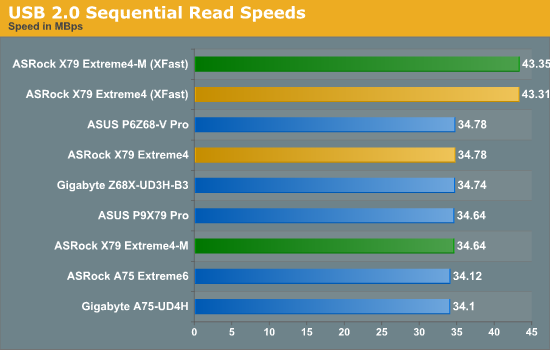
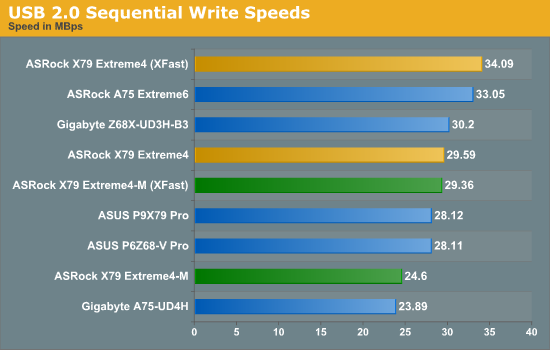
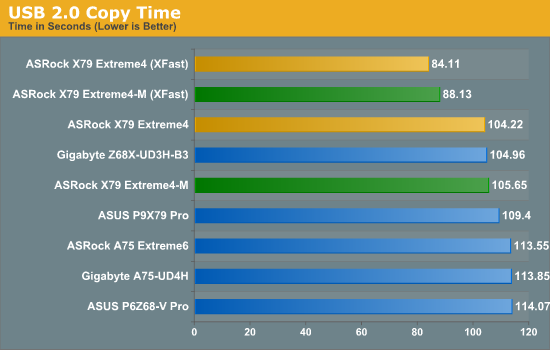
Despite the poor sequential performance of the Extreme4-M, under XFast mode, both boards outperform the rest in the USB 2.0 copy tests, especially the Extreme4.
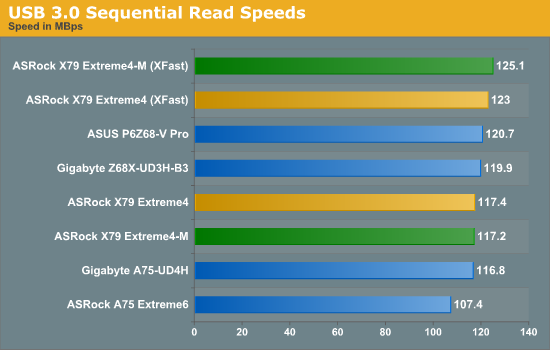
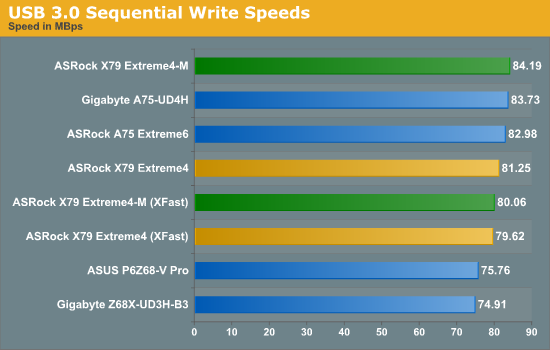
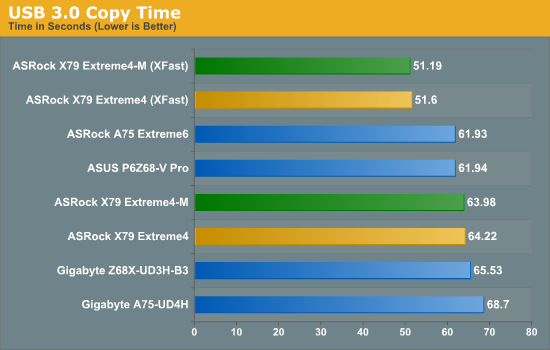
Both boards, under XFast mode, steam past all the other boards in our USB 3.0 copy test, with a 20% decrease in time required.
SATA Testing
We also use CrystalDiskMark for SATA port testing. The operating system is installed on the SSD, and the sequential test is run at the 5 x 1000 MB level. This test probes the efficiency of the data delivery system between the chipset and the drive, or in the case of additional SATA ports provided by a third party controller, the efficiency between the controller, the chipset and the drive.
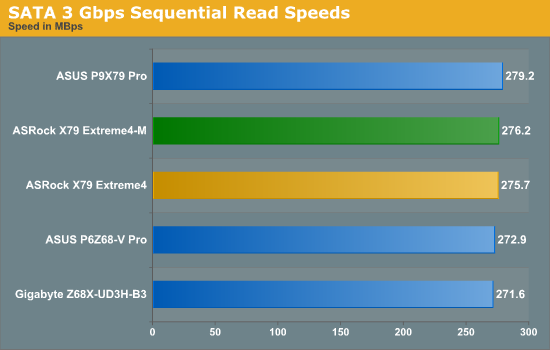
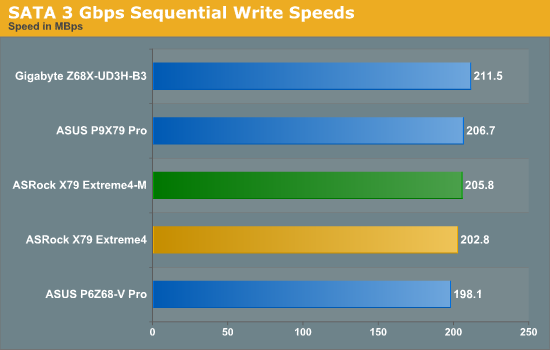
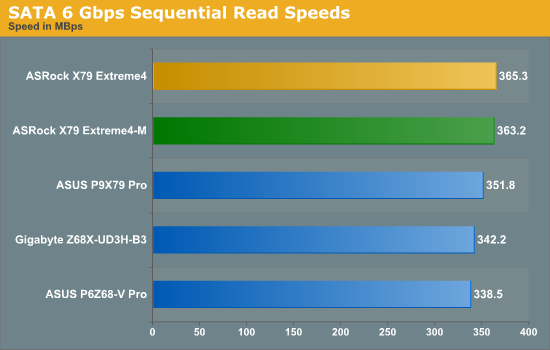
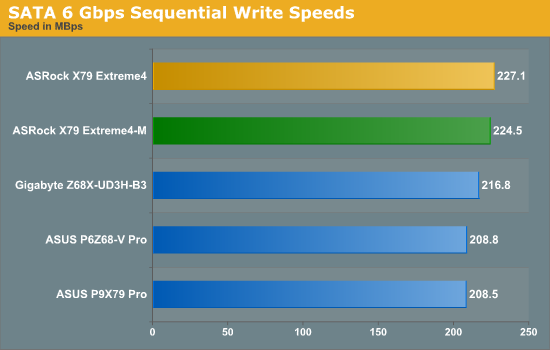
While neither board shines in SATA 3 Gbps testing, in terms of SATA 6 Gbps on our C300, both the X79 Extreme4 and X79 Extreme4-M beat the other X79 and Z68 comparison points.
DPC Latency
Deferred Procedure Call latency is a way in which Windows handles interrupt servicing. In order to wait for a processor to acknowledge the request, the system will queue all interrupt requests by priority. Critical interrupts will be handled as soon as possible, whereas lesser priority requests, such as audio, will be further down the line. So if the audio device requires data, it will have to wait until the request is processed before the buffer is filled. If the device drivers of higher priority components in a system are poorly implemented, this can cause delays in request scheduling and process time, resulting in an empty audio buffer – this leads to characteristic audible pauses, pops and clicks. Having a bigger buffer and correctly implemented system drivers obviously helps in this regard. The DPC latency checker measures how much time is processing DPCs from driver invocation – the lower the value will result in better audio transfer at smaller buffer sizes. Results are measured in microseconds and taken as the peak latency while cycling through a series of short HD videos - under 500 microseconds usually gets the green light, but the lower the better.
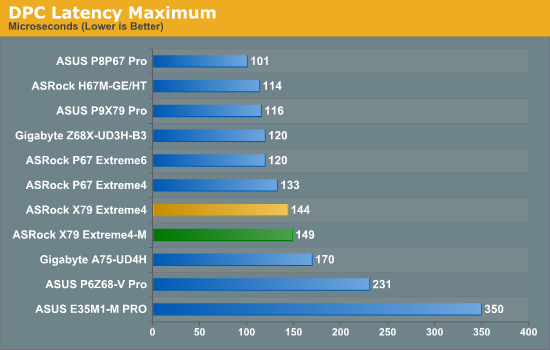
DPC Latency seems to be majorly dependent on the BIOS - it also helps if there is no CPU/fan monitoring software in the background. Both boards here perform well under 500 microseconds, but nothing stellar compared to other products.










54 Comments
View All Comments
Tom Womack - Monday, December 12, 2011 - link
I'm a computational mathematician; SNB-E is interesting because it's a fast processor with four fast memory controllers. I have no desire whatsoever for crossfire; I'd be happy with an on-board ATI Rage128 and no PCIe slots, if that made the board a hundred dollars cheaper. I don't really need SATA controllers; USB stick with the OS on and data on NFS is fine by me. But I would quite like eight DIMM slots because I use memory as if it's going out of fashion.Is there a product for this market?
opti2k4 - Monday, December 12, 2011 - link
I have Asrock p67 extreme4 and i am curious did you test manual voltage settings of CPU vCore ?Few different boards and different chipsets have same bug. When you put manual vcore value in bios, you turn off computer and power it on, vcore is not the set vaule, instead it's on value that would be when you put automatic settings.
So my i7 2600k has 1.165V set in bios, when i power on computer its is on 1.3V!!!! Then i have to go inside BIOS, pick any other different value (1.160V), save and exit and just then the correct voltage value is set on vcore. Then again i have to restart and put back 1.165V. This fault is generated by very bad bios coding of asrock engineers. I'll never go to cheaper solution again, Asus FTW!
Regards,
opti2k4
kwokfc - Monday, December 26, 2011 - link
1.368v load @ 4.8Ghz HT on. Bios 1.6 Aircool with NH-D14. So far so goodNPWW - Friday, October 9, 2015 - link
Can someone help me. If I want to run a simple test off this motherboard using only bare minimum hardware, What do I need? Hard drive, power supply, memory, fan and ect